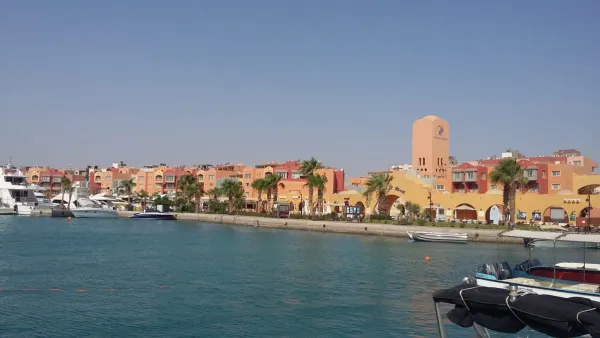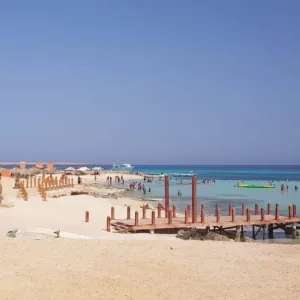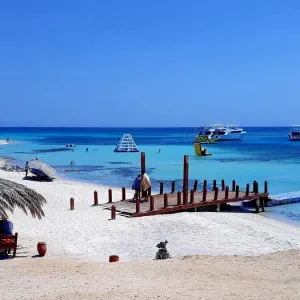Hurghada was once a relatively small and unimposing fishing village located next to the Red Sea, boasting several superb beaches. Now, the resort of Hurghada is almost unrecognisable compared to its past life. It has grown to become the most visited tourist destination in Egypt, with more than 100 different hotels, many of which line the shoreline.
Famous for its superb diving opportunities, Hurghada is especially appealing to those with little scuba diving experience who marvel at the underwater reefs and remarkable marine life. Presently, tourism constitutes a considerable part of Hurghada’s income. Each year, many tourists combine their holidays with visits to other prominent locations along the Nile Valley, including the nearby city of Luxor.
- Location of Hurghada City
Hurghada City stretches for about 40 kilometres along the shoreline of the Red Sea, Al-Bahr Al-Ahmar governorate. It lies 225 kilometres from the nearest governorate (Qena) in the Nile valley and 446 kilometres south of Cairo. Ras Garib borders it in the north. In the opposite direction,Safaga exists the south of it. At the same time, the Red Sea coast borders it in the east and the Assiut governorate in the west.
- Overview
Hurghada was founded in the early 20th century. It was a small fishing village for many decades, but it has grown into a significant Red Sea resort due to Egyptian and foreign investment in the 1980s. Holiday resorts and hotels provide windsurfing, kitesurfing, yachting, scuba diving and snorkelling. The city is known for its watersports, nightlife and warm weather. Daytime temperatures are around 30 °C (86 °F) most of the year, and during July and August, temperatures can reach over 40 °C (104 °F). Hurghada is a popular holiday destination for Europeans, especially during the winter, and some spend Christmas and New Year there. Russia’s tourist numbers dropped significantly after the Metrojet Flight 9268 plane crash in November 2015.
Hurghada extends for about 36 kilometres (22 mi) along the coast but does not reach far into the surrounding desert. The resort is a destination for Egyptian tourists from Cairo, the Delta and Upper Egypt and holiday tourists from Europe.
- Population
Hurghada has a population of 248,000 and comprises the following areas:
El Ahia and El Helal – the northern part
El Dahar (Downtown) – the old town
Saqqala – the city centre
El Kawsar – the modern part
El Mamsha (Village Road) – a pedestrianised street with a length of over 4 km (2.5 mi)
- Hotels
Many of Hurghada’s newer hotels, restaurants, and shops open doors along El Mamsha. Most of the most recent and significant hotel resorts exist between Mamsha and Sahl Hasheesh on El Mamsha. Beyond Sahl Hasheesh, there are the hotels of Makadi Bay. Dahar is the oldest part of the town, where the traditional bazaar, the post office and the long-distance bus stations (Go Bus and Upper Egypt Bus) are situated. The busiest area is Sakala, the “city centre” on Sheraton Road, where hotels, shops, and restaurants are located.
- Airport
The city is served by the Hurghada International Airport, with scheduled passenger traffic connecting to Cairo and several European cities. A new terminal was opened in 2015 to accommodate increasing traffic.
- History
Hurghada is one of the Al-Bahr Al-Ahmar governorates on the Red Sea coast. The Egyptians founded the present city in the early 20th century. Until recently, it was a small fishing village with a small population. Since the 19th century, Egyptian and foreign investors have continually enlarged the city to become the leading coastal resort on the Red Sea. In 1913, mining companies discovered oil in the area. Although, its actual production and export only began in 1921 under British oil magnates.
Fishing Village
The village, which later evolved into the city of Hurghada, was first settled in 1905. It acquired its name from a plant that has grown there naturally since Ancient Egypt. Originally, Hurghada was a fishing village. Oil was discovered in the area in 1913, and in 1921 British oil companies began their production and export. During the reign of King Farouk, a recreational centre was built in the city, but after President Nasser nationalised Egypt’s industries, it was reallocated to the Egyptian Armed Forces.
- Administrative Divisions
At present, Hurghada city has the following three main areas:
El Dahar is the old Downtown.
Sekalla is the city centre and the old part of the city.
Also, El Qura is the modern part.
In addition to these three main divisions, Hurghada has several suburbs. On the contrary, it has no villages as in the cities located in the Nile Valley.
- Hurghada Attractions
Hurghada city is an ideal resort to spend time on. This city has yearlong sunshine, incredible beaches and a crystal-like water sea. It lies at the side of the Red Sea, and a vast desert surrounds it. Besides, it has countless exciting attractions to explore. For ideas, see the following list of the top tourist attractions and places to visit in Hurghada:
Abdulmoneim Riadh Mosque.
El-Mina Grand Mosque.
Saint Shenouda Church Hurghada.
Hurghada Marina Boulevard.
Fish Market.
Fruit Market.
El Dahar Market.
Marine Port.
Giftun Islands.
Hurghada Grand Aquarium.
Jungle Aqua Park.
Hurghada Museum.
Sand City.
Mini Egypt.
Hard Rock Café.
Also, Little Buddha.
by www.egyptboats.com



























Comments